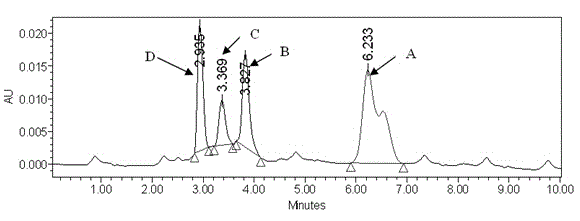Esterase gene estZ, esterase gene estZ encoded protein and application of esterase gene estZ
An esterase and gene technology, applied in the esterase gene estZ and its encoded protein and application fields, can solve problems such as ecosystem damage and threats to human life and health, improve the quality of agricultural products, solve the problem of excessive pesticide residues, and increase additional value effect
- Summary
- Abstract
- Description
- Claims
- Application Information
AI Technical Summary
Problems solved by technology
Method used
Image
Examples
Embodiment 1
[0038] Example 1 Esterase gene est Z clone (see figure 1 )
[0039] S1. Construction of transposon mutant library
[0040] Utilizing the principle of transposon mariner random insertion mutation, using the method of parental strain hybridization, Pseudomonas aeruginosa ( Pseudomonas aeruginosa ) strain PAO1 and transposon strain E. coli S17-1(pBT20) was used as the parent for parental conjugation, and the transposon mariner was randomly inserted into the PAO1 genome, and the mutant strains were screened by using the gentamicin resistance gene on the transposon and whether a hydrolysis circle was generated during the degradation process. In this way, mutant strains with loss of degradation function were obtained.
[0041] S2. Tail-PCR flanking sequence amplification
[0042] Design left-wing nested specific primers and right-wing nested specific primers based on the known insert sequence of the transposon mariner, combined with random degenerate primers suitab...
Embodiment 2
[0045] Example 2 Esterase gene est Z Highly expressed in BL21 (pET28a(+)) (see figure 2 )
[0046] S1. Esterase gene est Z PCR amplification
[0047] With forward primer P1:GC TCTAGA TGCCGGCGCAAATAGCCAT (SEQ ID NO.3) and reverse primer P2: CG GAATTC ATGTCTTCTCAAAGGGC (SEQ ID NO.4) is a primer, using PCR method from Pseudomonas aeruginosa ( Pseudomonas aeruginosa ) the esterase gene was amplified in the total DNA of strain PAO1 est Z fragment.
[0048] PCR amplification system:
[0049]
[0050] PCR amplification program:
[0051] Pre-denaturation at 95 °C for 3 min, denaturation at 94 °C for 30 s, annealing at 55 °C for 45 s, extension at 72 °C for 1 min and 30 s, after 34 cycles, extension at 72 °C for 5 min, and finally stored at 16 °C .
[0052] S2. The PCR product was digested with BamH I and EcoR I
[0054]
[0055] Placed in a 37 °C water bath for more than 2 h.
[0056] The digested p...
PUM
 Login to View More
Login to View More Abstract
Description
Claims
Application Information
 Login to View More
Login to View More - R&D
- Intellectual Property
- Life Sciences
- Materials
- Tech Scout
- Unparalleled Data Quality
- Higher Quality Content
- 60% Fewer Hallucinations
Browse by: Latest US Patents, China's latest patents, Technical Efficacy Thesaurus, Application Domain, Technology Topic, Popular Technical Reports.
© 2025 PatSnap. All rights reserved.Legal|Privacy policy|Modern Slavery Act Transparency Statement|Sitemap|About US| Contact US: help@patsnap.com



